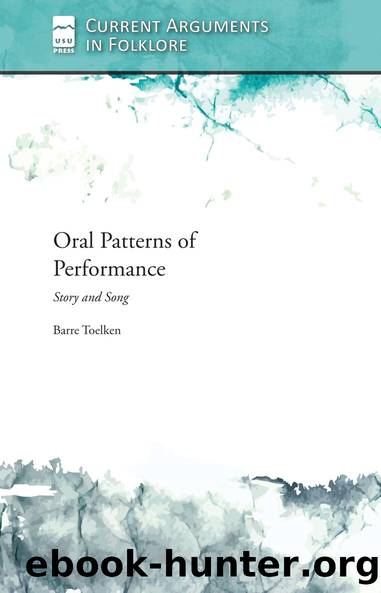Oral Patterns of Performance by Barre Toelken

Author:Barre Toelken [Toelken, Barre]
Language: eng
Format: epub
Google: d9NjrgEACAAJ
Publisher: Utah State University Press
Published: 2003-01-15T04:06:35+00:00
I have an idea that the full meaning and emotional force of this occasionally humorous tragedy will elude us. Even so, many fascinating things are going on in the story, and we can ask some fairly pointed questions about them. For example, we notice several places where the narrator must have illustrated his story with hand gestures, such as when the man âslapped this wayâ when he accidentally struck the grizzlyâs vulva by thrashing around, or when the narrator describes the grizzlyâs hands as âthat large her paws.â What other gestures, volume levels, facial expressions, or eye contact did he use? We have little indication, for Boas was mostly looking for language examples, not performance styles, unfortunately.
We can observe that the activities in Part I essentially depict male hunters going after meat, while those in Part II describe women harvesting berries and salmon. Part I is mostly about human behavior; Part II is mostly about the behavior of the bear. Part I takes the human characters away from the familiarity of a tribal town and toward unforeseeable, open nature in the woods; Part II takes a bear in the opposite direction: away from the woods and into town. The oldest, âimproperâ brother is welcomed into the family of the great grizzly bear (once the possibility of killing is converted by the female to sex) in Part I, while the great grizzly is welcomed into the family life of the town (once they get used to her odd way of carrying berries) in Part II. Yet, as we see toward the end, the berries episode is not fully accepted by the people, for the angry young man uses it to scold the bear. And even though the great grizzly works hard to harvest enough salmon to distribute to everyone, she is apparently doing it wrongâpresumably by not letting anyone else help in a process that is normally shared among the townspeople. The man, who in Part I has saved his own life by accepting marriage with the grizzly bear (what options did he have, one wonders?), nonetheless eventually misses his family and wants to return to them. In spite of sexual intimacy, life among the bears isnât entirely satisfying; indeed, he is described as âlost.â Similarly, though the grizzly in Part II gets along amazingly well with her husbandâs family and her cowife, calms the baby, supplies food (if you donât mind her processing method), and labors diligently at the fish trap, she somehow isnât fitting in. She is still a grizzly bear living away from her natural element in a human town. When the young sister first sees the grizzly and runs in fear, she is providing an important commentary found in many Northwest stories: The young can often seeâand be honest aboutâsomething that the grownups are trying to overlook to be polite.
In the stories about women marrying bears, the union lasts a considerable time, and the woman has children by her grizzly husband. Nonetheless, sooner or later, realities seep into the story: Hunters are out looking for bearsâthatâs what hunters do.
Download
This site does not store any files on its server. We only index and link to content provided by other sites. Please contact the content providers to delete copyright contents if any and email us, we'll remove relevant links or contents immediately.
Cecilia; Or, Memoirs of an Heiress — Volume 1 by Fanny Burney(31361)
Cecilia; Or, Memoirs of an Heiress — Volume 3 by Fanny Burney(30958)
Cecilia; Or, Memoirs of an Heiress — Volume 2 by Fanny Burney(30915)
The Great Music City by Andrea Baker(21929)
We're Going to Need More Wine by Gabrielle Union(18096)
Bombshells: Glamour Girls of a Lifetime by Sullivan Steve(13129)
Pimp by Iceberg Slim(12959)
All the Missing Girls by Megan Miranda(12791)
Fifty Shades Freed by E L James(12470)
Talking to Strangers by Malcolm Gladwell(11928)
Norse Mythology by Gaiman Neil(11923)
Crazy Rich Asians by Kevin Kwan(8383)
Mindhunter: Inside the FBI's Elite Serial Crime Unit by John E. Douglas & Mark Olshaker(7863)
The Lost Art of Listening by Michael P. Nichols(6497)
Enlightenment Now: The Case for Reason, Science, Humanism, and Progress by Steven Pinker(6425)
Bad Blood by John Carreyrou(5794)
The Four Agreements by Don Miguel Ruiz(5542)
Weapons of Math Destruction by Cathy O'Neil(5064)
We Need to Talk by Celeste Headlee(4893)
